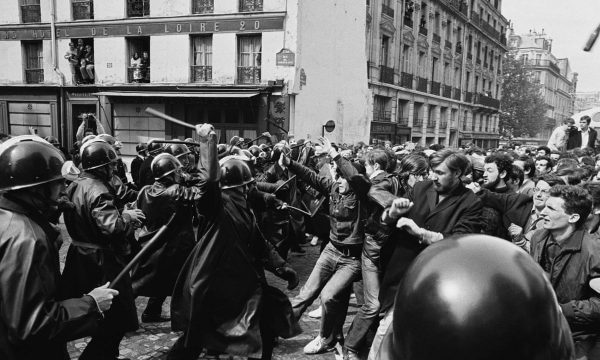Last updated: 6/24/2021
Note: This essay is a work in progress.
Thesis: Just as fascism was borne out of the conditions of modernity, we are witnessing a new form of reaction characteristic of the postmodern era.
Further Reading:
- The Origins of Nazi Violence by Enzo Traverso
- Eichmann in Jerusalem by Hannah Arendt
- The Rise of Postmodern Conservatism by Matthew McManus
Reaction isn’t limited to any historical movement; over time it constantly undergoes transformations in name, appearance, and manifestation. To some eras it was known as legitimism, in others fascism.
It must be stressed that reaction isn’t an ideology or set of values, but rather instead a historical phenomenon. The traditional analysis has been that as society undergoes major changes in its evolution, groups secure in the previous status quo found themselves at risk of displacement. From this fear we get the characteristic symptoms of mass hysteria, totalitarianism, and chauvinism.
Understood in this light, the reactionary is a product of his time, his worldview being entirely contextual. Reaction forms in response to action. Without taking this into account, one will have a difficult time undergoing a proper dissection of the far-right.
Perhaps then it’s no surprise that leftists who continue to neglect this fact can only stand perplexed as the far-right appears to them far more adept and organized than they could ever be. It’s a rather muddy subject as to how accurate this perception is; what is clear, however, is that the perception itself is very real.
Many have responded to this insecurity with a “left-populism”: a fantasy in which the left too can share in the New Right’s success as long as they come down from their ivory towers and speak eye to eye with the common man. After all if the right can see a resurgence by telling lies to Joe Sixpack, imagine what will occur when they hear the truth!
Prisoners of their post-political dogmas, and reluctant to admit their mistakes, they cannot recognize that many of the demands articulated by right-wing populist parties are democratic demands, to which a progressive answer must be given. Many of those demands come from the groups who are the main losers of neoliberal globalization, and they cannot be satisfied within the neoliberal project.
Classifying right-wing populist parties as ‘extreme-right’ or ‘neo-fascist’ and attributing their appeal to lack of education is of course especially convenient for the forces of the centre-left. It is an easy way to disqualify them, without recognizing the centre-left’s own responsibility in such an emergence. By establishing a ‘moral’ frontier so as to exclude the ‘extremists’ from the democratic debate, the ‘good democrats’ believe that they can stop the rise of ‘irrational’ passions. Such a strategy of demonization of the ‘enemies’ of the bipartisan consensus can be morally comforting, but it is politically disempowering.
To stop the rise of right-wing populist parties, it is necessary to design a properly political answer through a left populist movement that will federate all the democratic struggles against post-democracy. Instead of excluding a priori the voters of right-wing populist parties as necessarily moved by atavistic passions, condemning them to remain prisoners of those passions forever, it is necessary to recognize the democratic nucleus at the origin of many of their demands. (Mouffe 2018)
This sort of approach is incredibly naive for reasons I’ve voiced before, so I’ll cut to the chase: the ultimate irony of this narrative is that its holes stem from being out of touch with how reactionaries operate, often falling hook, line, and sinker for the very deception they decry. There’s a whole web of details to unravel, and without properly separating the meat from the skin, it’s very easy to get misled.
1. Fascism (in progress)
Fascism is a term that gets thrown around a lot, and is in a lot of contexts treated as synonymous with reaction itself. Defining it as such is rather misleading, given that fascism was borne out of specific historical circumstances.
Formally, fascism is a product of the 20th century and it for all intents and purposes can be considered dead in the modern day. Can individuals still espouse fascist views? Sure, but that alone can’t make up a movement. Plenty of people self-identify as monarchists but that does not mean that (non-ceremonial) monarchy is a presence in the present day.
(The main exception which should be noted is developing countries, whose historical trajectory does not mirror that of those in the stage of de-industrialization. How fascism manifests in those areas would require an investigation of its own.)
This distinction may seem rather semantic but I assure you, there’s a good reason to bring this all up. When we take a specific form of reaction to be something trans-historical, we end up neglecting the dynamic character of the phenomenon. And it’s this dynamic character which tends to give reactionaries a lot of leeway when it comes to gaming the public sphere.
1.1. Modernity (section in progress)
The assumption has long been that reactionaries long for or wish to resurrect the past, yet the history of fascism seems to contradict this. What we see is a simultaneous embrace and rejection of modernity; the blending of past, present, and future. All of this converges on the myth of the nation, an entity understood as something timeless.
1.2. The Banality of Evil
1.3. Asymmetry
2. New Right (section in-progress)
The messy thing about the New Right is that while its intellectual roots date multiple decades ago, its only over the past decade that we’re really beginning to see the movements take a tangible form.
2.1. Liquid Modernity
2.2. Metapolitics
2.3. Behind the Curve
3. Neo-Reaction
3.1. Pastiche
3.2. Postmodernity
Blogger and software engineer. I write on tech, politics, and theology.

